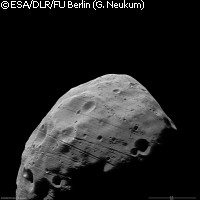ESA spacecraft snaps best pictures yet of Martian moon
The European Space Agency's Mars Express spacecraft has taken the most detailed images ever of the Martian moon Phobos. The pictures, which ESA describes as 'the best images of Phobos ever', reveal previously unseen details of the moon's surface. For example, the pictures offer an unprecedented view of two sets of grooves running in different directions which can be clearly seen, as can a winding chain of craters. The pictures will clearly be of interest to those studying Phobos. Among other things, they could help to shed light on the origins of the grooves; some believe that they are the result of material thrown up from impacts on Mars, while others suggest that they arose when dust and small stones on the surface slipped into internal fissures. The Russians are also keen to get their hands on the new images; they plan to send a spacecraft to Phobos next year to collect soil samples, and they hope the photos will help them to pick a suitable landing spot. The pictures were taken by the High Resolution Stereo Camera (HRSC) on board the Mars Express. Over a period of three weeks, Mars Express flew past Phobos a number of times, capturing images from a wide range of angles and flying to within 100 km of the moon. The most detailed pictures have a resolution of just 3.7 metres per pixel and are taken in five channels for pictures in 3D. Furthermore, a photometric channel with a resolution of 7.4 metres per pixel will facilitate further studies into the physical structures of Phobos. Mars Express also succeeded in capturing the first ever high resolution images of some parts of the far side of Phobos (like the Earth's moon, it always turns the same side to its planet). Previous images of Phobos had a lower resolution, were not available in 3D and did not cover the entire disc. Mars Express was able to capture these high quality images thanks to its highly elliptical orbit around Mars which took it outside Phobos' own orbit. This made it possible to study the side of Phobos which faces away from Mars. Obtaining high quality images while travelling at high speeds represented a major challenge for the engineers involved in the project. To get around this, they performed a manoeuvre called a 'spacecraft slew'. This entails rotating the body of the spacecraft against the direction of motion, thereby effectively lowering the speed at which the target passes in front of the camera. As a result, excessive motion blurring of the pictures was avoided. Meanwhile, the Mars Express team is optimistic that the remaining, unavoidable blur can be reduced when the images are processed further. Phobos is the larger of Mars' two moons, measuring 27 km by 22 km by 19 km. It is described by scientists as a 'small irregular body', and is one of the least reflective objects in the Solar System. It is not known whether it is a capture-asteroid or a remnant of the material that formed the planets. It orbits Mars at a distance of just over 9,000 km (in comparison, Earth's moon orbits at a distance of over 384,000 km from our own planet). Mars' other, smaller moon is called Deimos.



